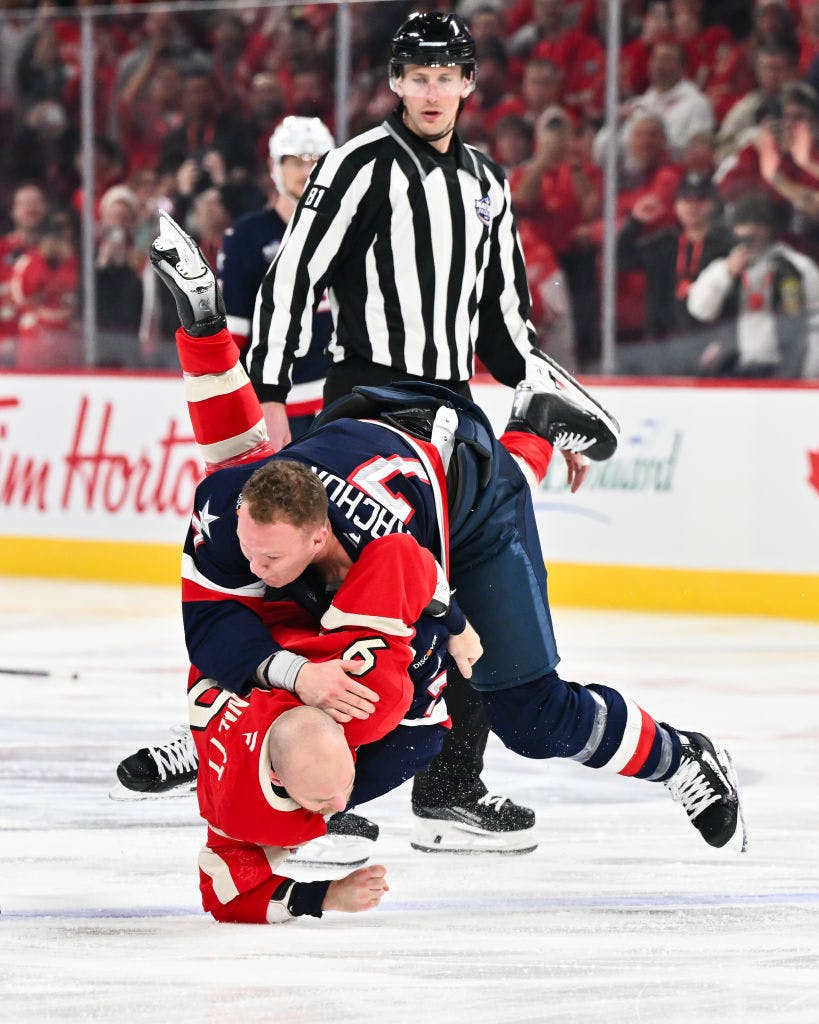How hockey fights became a dying breed, despite the flurry of fisticuffs between Canada and the US
The average number of fights per game in the NHL is down from a peak of about 1.2 to around 0.24.
The must-watch hockey game between Canada and the US on Saturday night provided entertainment not just from the skill on display, but also the explosion of fisticuffs from the moment the puck dropped.
Within the first nine seconds, six players dropped their gloves and squared off, throwing punches at an opponent. Extrapolated to the point of absurdity, that works out to 400 fights in the game — which is about 50% more than the entire 2023-24 regular season as a whole!
Instances of an on-ice fight — also known as a scrap, tilly, Donnybrook, and a dozen other colorful nicknames — have dwindled over time when these players are suiting up for their National Hockey League franchises.
The 1983-84 season marked “Peak Fight,” with 1.17 fights per game. That figure roughly halved from then through 2009 to a little less than 0.6 per game, and continued to sink to about 0.24 for the latest full season:
Why?
It’s dangerous: A 2023 study showed that so-called enforcers (that is, frequent fighters) tended to die 10 years earlier than other players. Notably, Derek Boogaard — who knocked out many opponents during his career scrapping in the show — passed at age 28 from an accidental overdose, with a posthumous brain scan showing he had chronic traumatic encephalopathy. Bob Probert, a legendary pugilist judged to be the winner of the top-rated fight in NHL history, was reportedly found to have suffered from the same disease after his death at age 45.
The analytics revolution: It was always tough to tell what, if any, marginal benefit accrued to a team for participating in or winning a fight. Meanwhile, the nerds have come for hockey, as they have for every sport. Franchises have much more insight on every player’s ability to gain and maintain possession of the puck, transport it away from their net toward their opponent’s goal, get pucks on net from dangerous positions, and prevent their opponents from doing any of the above. The Venn diagram of “players deemed to be valuable based on these metrics” and “classic enforcers” has very little overlap.
The introduction of a salary cap for the 2005-06 season: Paying a would-be goon a couple million dollars to either play minimally or sit in the press box and lace up skates once a week to try to beat up another team’s enforcer is simply not a good use of limited financial resources, especially when, as mentioned, fighters tend not to be that proficient at driving play in a way that increases their team’s odds of victory (*cough* Ryan Reaves *cough*).
Rule changes to discourage fighting/fighters: For instance, the “instigator rule” added an extra penalty if a player was judged to be the one who started a fight, and delivered its intended effect of decreasing the number of bouts (per a 2022 study). All but a handful of NHLers are now required to wear visors on their helmets, which, when coupled with mandates that punish the voluntary removal of one’s helmet during a tilly, increases the risk of hand injuries during a fight. Lower levels of hockey have also cracked down on fighting even more severely, which means there’s much less institutionalized fighting knowledge and experience from those coming up the ranks. And a sweeping series of rule changes ahead of the 2005-06 season to promote scoring both placed a premium on speedy, puck-moving skaters and curbed the ability of fighters to use their on-ice assets — their typically large frames and physicality — to disrupt opponents without risking a penalty.
But perhaps because of their rarity, there is nothing — nothing — like an old-fashioned Donnybrook to turn me from a cool-headed observer of financial trends into a crazed maniac hollering obscenities and making loud indistinct noises at the TV.
I’m not alone in being entertained: 4.4 million Americans watched Saturday’s game. That viewership exceeds any of the first six games of 2024’s Stanley Cup Finals. That’s a potential shot in the arm for a sport that has seen TV ratings drop as the NHL battles for attention with the other major North American sports leagues.
Canada and the US will battle again tonight to determine the winner of the inaugural Four Nations Face-Off, with the NHL regular season poised to resume on Saturday.
